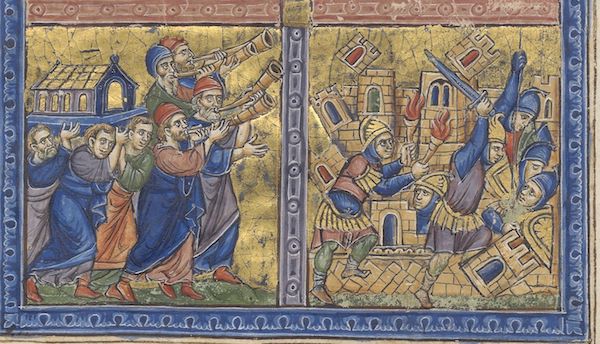We run our website the way we wished the whole internet worked: we provide high quality original content with no ads. We are funded solely by your direct support. Please consider supporting this project.

Reading the Bible “by Faith”
The cruciform approach to reading the Bible—and specifically the culturally-conditioned and sin-stained portraits of God—requires faith on the part of the reader, which I argue in Crucifixion of the Warrior God. On one level we can discern by faith that often times God broke through the limitations and sin of the ancient authors, for we find divine portraits that, to one degree or another, reflect the character of God revealed in Christ. On another level we must discern by faith that God appropriated the limitations and sin of the authors God “breathed” through, for we find divine portraits that, to one degree or another, anticipate the ugliness of the sin-bearing, God-forsaken criminal on the cross. Of course, I am painting with broad brush strokes. In reality, most portraits in the Old Testament are Christ-like to a certain extent and reflect the culturally conditioned and sin-stained humanity of their authors to a certain extent.
To the extent that a divine portrait reflects the character of Christ, it may be regarded as a direct revelation of God’s character. For as with the teachings and actions of Christ, the content of this type of divine portrait directly reflects God’s true, Christ-like character. Conversely, to the extent that a divine portrait conflicts with the character of Christ, it must be regarded as an indirect revelation of God. This calls for a different kind of faith. For as with Christ when he bore our sins and took on the semblance of a guilty, God-forsaken criminal, the content of this type of divine portrait reflects the limitations and sin of God’s covenantal people more than it does his true character.
Along the same lines, as with the sin-bearing Christ on the cross, the indirect revelatory content of this type of divine portrait must be located not at the level of appearances, but in what happened behind these appearances, in what could be called the “meta-dimension” of these appearances. To put the matter in slightly different terms, we only discern the character of God on Calvary when, by faith, we look through the grotesque appearance of this guilty criminal and discern in the depth of this event the unfathomably merciful God stooping to this unthinkable level. We can discern the true character of God in OT divine portraits that look like standard ANE portraits of warrior deities when we, by faith, look through the barbaric appearances to discern the unfathomably merciful God stooping to this unthinkable level.
As such, to the extent that any OT portraits reflects the limited and sinful humanity of God’s people, and insofar as we discern the limited and sinful humanity of God’s people in any other aspect of Scripture, we may discern a harbinger and type of the cross. The same faith that enables us to discern the self-sacrificial God in the depth dimension of the limited and fallen “criminal” who hung on the cross is the faith that enables us to discern the self-sacrificial God in the depth dimension of Scripture’s violent portraits of Yahweh, as well as every other aspect of Scripture that reflects the limited and sinful humanity of its authors. And all of this, I submit, bears witness to the unfailing covenantal love of God.
Image: Bibliothèque de l’Arsenal, Ms-5211 réserve, fol. 69v.
Category: General
Tags: Bible, Cruciform Theology, Faith
Related Reading

5 Differences Between The Kingdom of God and the Kingdom of the World
Image by matthijs rouw via Flickr The kingdom of God looks and acts like Jesus Christ, like Calvary, like God’s eternal, triune love. It consists of people graciously embracing others and sacrificing themselves in service to others. It consists of people trusting and employing “power under” rather than “power over,” even when they, like Jesus, suffer because…

Paul Teaches Free Will, Not Determinism: Romans 9, Part 3
In this series of posts, I am challenging the deterministic reading of Romans 9, which interprets Paul’s teaching as saying that God chooses some to be saved and others to be damned. There are six arguments that I offer to challenge this popular view. Today, I will look at the fourth. Argument #4: Paul’s Summary and…

Why Bart Ehrman Doesn’t Have to Ruin Your Christmas (Or Your Faith) Part 8
This is the eighth of several videos Greg put together to refute Bart Ehrman’s claims published in the article What Do We Really Know About Jesus? In this segment, Greg gets into the nitty gritty of why portions of the birth account are not the dumbest lie ever. If you missed the first seven installments you can…

What Bible Translation Do You Recommend?
Greg talks about Bible translations. http://traffic.libsyn.com/askgregboyd/Episode_0051.mp3

Podcast: How Do You Teach a Cruciform Hermeneutic from the Pulpit?
Greg talks about infallibility and inerrancy. http://traffic.libsyn.com/askgregboyd/Episode_0281.mp3

Why Bart Ehrman Doesn’t Have to Ruin Your Christmas (Or Your Faith) Part 7
This is the seventh of several videos Greg put together to refute Bart Ehrman’s claims published in the article What Do We Really Know About Jesus? In this segment, Greg argues against Ehrman’s claim that the Roman census in the birth narrative was fabricated. If you missed the first six installments you can find them here, here, here, here, here and here.
